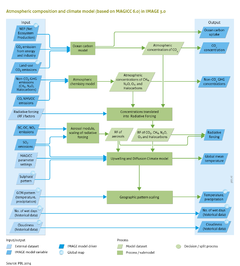Atmospheric composition and climate/Policy issues: Difference between revisions
Jump to navigation
Jump to search
m (Text replace - "Policies for land and biodiversity" to "Land and biodiversity policies") |
m (Text replace - "Policies for air pollution and energy security" to "Air pollution and energy policies") |
||
| Line 6: | Line 6: | ||
*Non-mitigation management of global radiative forcing; for example, via geo-engineering (Figure 6.3.3.) ([[Van Vuuren and Stehfest, 2013]]). | *Non-mitigation management of global radiative forcing; for example, via geo-engineering (Figure 6.3.3.) ([[Van Vuuren and Stehfest, 2013]]). | ||
|Example=Policy interventions that affect future climate range from deliberate climate policy on energy and agricultural systems, air pollution measures, and many land-use policies to direct management of radiative forcing. Examples of the type of measures that can be analysed using the IMAGE system include energy efficiency, use of low-carbon fuels, reduction in non-CO2 greenhouse gas emissions and reduction of deforestation ([[Overmars et al. (unpublished)]]). The interventions that are related to policies on climate, air pollution and land use are described in [[Climate policy]], [[ | |Example=Policy interventions that affect future climate range from deliberate climate policy on energy and agricultural systems, air pollution measures, and many land-use policies to direct management of radiative forcing. Examples of the type of measures that can be analysed using the IMAGE system include energy efficiency, use of low-carbon fuels, reduction in non-CO2 greenhouse gas emissions and reduction of deforestation ([[Overmars et al. (unpublished)]]). The interventions that are related to policies on climate, air pollution and land use are described in [[Climate policy]], [[Air pollution and energy policies]] and [[Land and biodiversity policies]]. These measures lead to a change in emissions, and then to the expected reduction in radiative forcing and climate change. The IMAGE calculations show that there is a considerable time lag between the moment policies are introduced and the subsequent impacts on climate change. Even if emissions are strongly reduced already by 2020 and onwards, it would take several decades for this change to result in a noticeable reduction in temperature within the global climate system (see figure below). In addition to these ‘standard’ climate measures, there is a range of policy interventions whereby the dynamics of the climate system play a prominent role. All of these, in principle, may be analysed using the IMAGE system | ||
}} | }} | ||
Revision as of 17:28, 11 December 2013
Parts of Atmospheric composition and climate/Policy issues
| Component is implemented in: |
|
| Related IMAGE components |
| Projects/Applications |
| Models/Databases |
| Key publications |
| References |
